|
Spode has been part of Stoke-on-Trent's industrial heritage for almost 250
years. On 6th November 2008 it called in administrators, who said the
china maker had been hit by the recession and left cash-strapped because
of a failure to sell part of its Church Road factory for development.
In April 2009 it was announced that the
Stoke based Portmeirion pottery company had bought Spode and Royal
Worcester from the hands of administrators, thus ensuring the continuance
of these names.
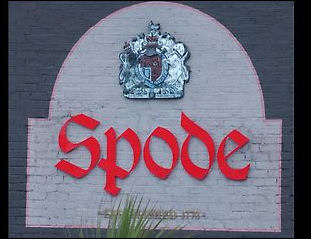
POTTERY has been manufactured at Spode's
Church Street site since around 1750, more than 10 years before Josiah
Spode established his business in 1767.
The success of the venture meant Josiah was
able to buy the Church Street factory from his former employer, William
Banks.
In the late 18th century Josiah produced what has been described as the
single most significant development in the history of his industry – the
perfection of the formula for fine bone china.
The Prince of Wales visited the factory in
1806 and, impressed by what he saw, asked Spode to produce the banqueting
service for his coronation as George IV. The company has held Royal
Warrants ever since, and has also received commissions from the East India
Company, Charles Dickens and the Shah of Persia.
In 1867 the company's official trade name
was changed to WT Copeland and Sons, only reverting back to Spode in 1970.
Spode is renowned for its blue and white Willow pattern, developed by the
original Josiah Spode from a pattern called Mandarin in about 1790.

Entrance to Spode
Pottery Works, Stoke
Main entrance to the Spode Pottery Works on
Church Street. Established c.1770, the pottery still (2009) occupies its original
site. The factory chimney is visible behind
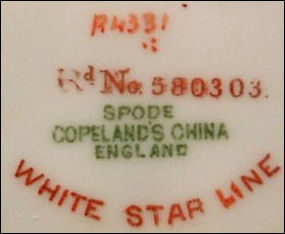
The backstamp for one of the dinner services
made for the ill fated Titanic
|
1) Josiah Spode
(1733-1797) Founder of the
Spode pottery manufactory and known as Josiah Spode I even though
his father was also a Josiah Spode.
Josiah I was born on 23rd
March 1733 - the only son of poor parents in Lane Delph a village in
Stoke-on-Trent, in Staffordshire, England. When he was six, his
father died and was buried in a pauper's grave.
From the age of 16 in 1749, Josiah
was apprenticed to one of the best potters in the area, Thomas
Whieldon.
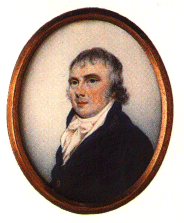
Josiah Spode I,
1733-97
He remained with Whieldon until he
was 21. After his departure, Spode seems to have worked for and in
partnership with other potters in the area. Independent research has
shown that there has been another pottery on the present Spode site
since 1751, Spode established a business in Stoke-on-Trent in 1767
and his outright ownership of the present works dates from 1776.
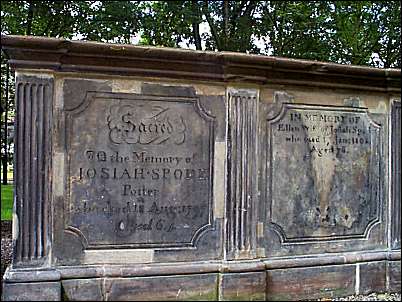
Tomb of Josiah
Spode I & his wife
Chest tombs of Spode family in the grounds of Church of St. Peter Ad
Vincula, Stoke
|
JOSIAH SPODE I
"Sacred to the memory of
JOSIAH SPODE
Potter
who died 18th August 1797
aged 64" |
Ellen Spode
"In memory of
Ellen, wife of Josiah Spode
who died 17 Jan 1802 aged 76"
|
2)
Josiah Spode II (1755-1827)
While his father (Josiah Spode
I) ran and developed the pottery works in Stoke Josiah Spode II
trained as a potter and ran the firm's warehouse in London.
He took over the
pottery factory from his father in 1797. Josiah Spode II led the
development of bone china, which became the standard English
porcelain body from about 1800 onwards.
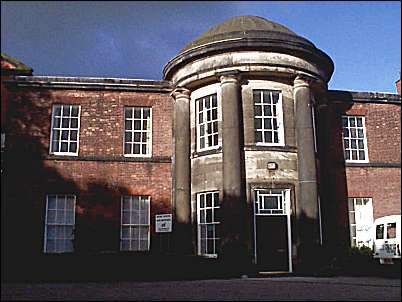
The Mount - home of
Josiah Spode II
"The Mount" was built
c.1803-4.
"Of
the mansions within the Township of Penkhull, (we may say, indeed,
within the compass of the Borough,) "THE MOUNT," erected by the late
Josiah Spode, Esq., bears acknowledged pre-eminence. It stands near
the village, and is surrounded by plantations and a
highly-ornamental domain. The house is an oblong building of stone,
with a semi-circular entrance on the west front; an elegant and
lofty dome"
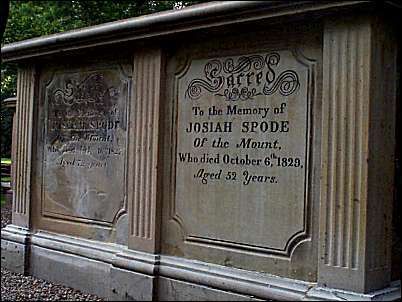
Josiah Spode the II
& III
|
JOSIAH SPODE II
"Sacred to the memory of
JOSIAH SPODE
of the Mount
who died July 16th 1827
aged 72 years" |
JOSIAH SPODE III
"Sacred to the memory of
JOSIAH SPODE
of the Mount
who died October 6th 1829
aged 52 years" |
3)
Copeland and Garrett
- William Copeland had become a partner in 1797 and after Josiah
Spode II died in 1827,
William
Copeland's son, William Taylor Copeland, bought the business from
the Trustees of
Josiah Spode III. Thus
in 1833 William Taylor became sole owner. But he took unto himself a
partner, Thomas
Garrett and the firm became 'Copeland and Garrett', continuing so
until 1847.
4)
The Copeland family
From
1847 William Copeland continued on his own.
In
1867 William Taylor Copeland's four sons were taken into partnership
- eventually the proprietorship devolved upon the youngest of the
four
sons, Richard P.
Copeland, whose sons in their turn are became the senior members of
the firm. In
1932, the
business was turned
into a private limited company, under the name of W. T. Copeland and
Sons Ltd.
The firm remained in the
Copeland family until 1966. The Spode brand name was used alongside the Copeland
name throughout the 19th and 20th centuries, often styled 'Copeland late Spode'.
In 1970 to commemorate the founder the company name was changed to Spode. |
Spode and
the Royal Warrants of Appointment
Royal Warrants are granted to people or
companies who have regularly supplied goods or services for a minimum of
five years to the Queen, the Duke of Edinburgh or the Prince of Wales.
The history of Spode and The Royal
Warrants of Appointment is as follows:
1806 - the first Royal Warrant was
awarded to Josiah Spode II following a visit by the Prince of Wales and
The Duke of Clarence to the Spode works in Stoke. He was appointed Potter
and English Porcelain Manufacturer to H.R.H. the Prince of Wales.
1820 - Potter to H.M. King George
IV
1866 - Manufacturers of China and Glass to H.R.H. The Prince of Wales
1901 - Manufacturers of China to H. M. King Edward VII
1910 - Purveyors of China to H.M. King George V
1938 - Purveyors of China to H.M. Queen Mary
1971 - Manufacturers of China to H.M. Queen Elizabeth II
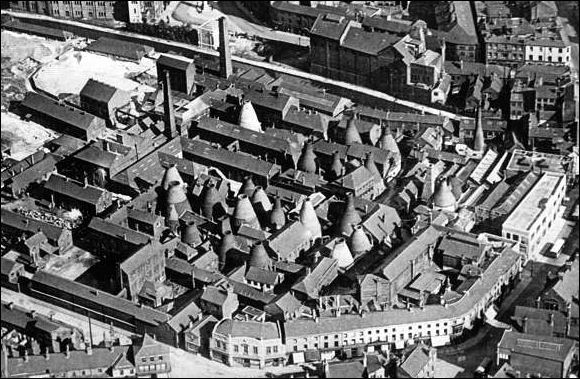
Spode works in 1927
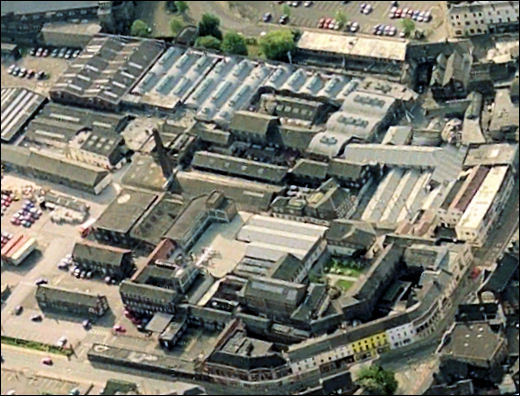
Spode works in 2008
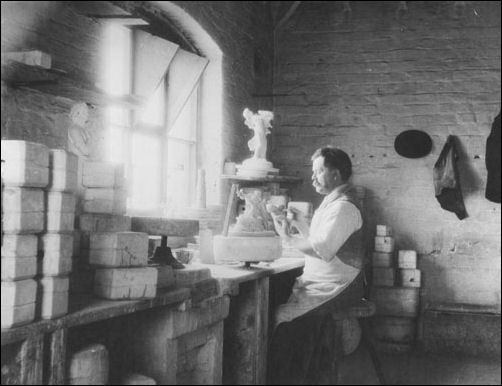
china figure making 2nd Aug 1899
Taken at the Spode pottery
factory, Stoke-on-Trent.
The modeller is
assembling Parian objects. Parian is the name given to the white biscuit
porcelain primarily associated with figure modelling.
A stack of moulds can be seen on the modeller's bench.
© Spode Museum
Trust
Staffordshire Past Track
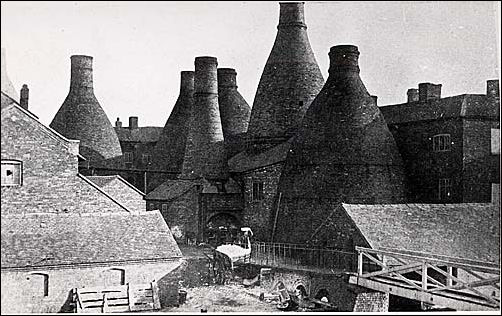
Bottle kilns at the Spode
works c.1900-1930
All these coal fired kilns
were demolished
and replaced with electric fired kilns.
- only the base of one of the old kilns remained.
© The Potteries Museum &
Art Gallery
Staffordshire Past Track
|

![]() also see the Spode
History BlogSpot which is run by Pam Wooliscroft who was the curator of
the Spode Museum Trust.
also see the Spode
History BlogSpot which is run by Pam Wooliscroft who was the curator of
the Spode Museum Trust.